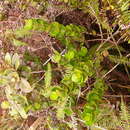Comprehensive Description
provided by Smithsonian Contributions to Botany
Alyxia latilitnba Grant
Frutex, 1.5–2 m altus, glaber, ramulis triangulatis vel subalatis, 2–3 mm crassis; folia verti-cillata terna sessilia vel petiolata, petiolis ad 4 mm longis, laminis late obovatis ellipticis vel vix ovatis 3.5–5.6 cm longis 2–3 cm latis basi cuneatis vel subrotundatis apice obtusis interdum parum attenuates coriaceis nitentibus lutei-viridibus subtus pallidi-oribus margine revolutis; cymae axillares 4-floriferae, pedunculis 10–15 mm longis, pedicellis 5 mm longis; calyx viridis tubo 0.4 mm longo, lobis ovati-lanceolatis 1.2–1.5 mm longis obtusis apice ciliolatis; corolla infundibulariforma lutea, tubo 5.5–6.5 mm longo 1–1.5 mm infra faucem parum dilatato parte supera intus villosa, lobis ovatis vel suborbiculatis parum asymmetricis 2.8–3 mm longis 2.5–3 mm latis, apice rotundatis ciliolatis; stamina filamentis 0.3–0.5 mm longis, antheris ovati-lanceolatis 1 mm longis includentibus; ovaria bina 0.6 mm longa basi longe villosa; stylus sin-gulus 4–4.5 mm longus glaber; stigma ovatum 0.6 mm longum barbatum; drupae geminatae ellipticae vel subglobosae (vel saepe dispermae moniliformae) 13 mm longae 12 mm latae 9 mm crassae parum apiculatae.
Shrub, 1.5–2 m high, glabrous. Twigs prominently 3-angled or subwinged, 2–3 mm thick, brown or gray, lenticels not prominent. Leaves verticil-late, in 3's, sessile or on petioles to 4 mm long, broad, obovate, elliptical or scarcely ovate, 3.5–5.6 × 2–3 cm, cuneate or rounded at base, obtuse and occasionally somewhat attenuate at the tip, coriaceous, shining, yellowish green, somewhat paler below, revolute, with 14–18 inconspicuous lateral veins. Cymes 4-flowered, peduncles 10–15 mm long, pedicels 5 mm long. Calyx tube 0.4 mm long; lobes ovate-lanceolate, 1.2–1.5 mm long, obtuse, ciliolate at the tip. Corolla salverform, yellow; tube 5.5–6.5 mm long, slightly expanded 1–1.5 mm below the throat; lobes ovate to suborbicular, somewhat asymmetrical, 2.8–3 × 2.5–3 mm, rounded at the tip, which is faintly ciliolate. Filaments 0.3–0.5 mm long; anthers ovate-lanceolate, 1 mm long, acute. Ovaries 2, 0.6 mm long, long-villous at the base; style 4–4.5 mm long; stigma ovoid, 0.6 mm long, bearded at the tip. Drupes (submature?) geminate, elliptical or subglobose (when 1-seeded), flattened ventrally, 13 × 12 × 9 mm, frequently moniliform (2-seeded) and then longer, minutely or not at all beaked, greenish. Embryo 7 mm long; cotyledons curved.
In leaf shape the species is rather close to A. scandens, but the leaves are much broader in proportion, more coriaceous, and somewhat more conspicuously revolute. The flowers are about ⅔ as large and the corolla lobes about half as long as in A. scandens. The species is named with reference to the broad blades and broad corolla lobes.
The St. John specimens cited below probably belong here, though we have no record of the shape of the corolla lobes. If these specimens do belong here the plant may reach 3 m tall and the ripe fruit is black, becoming 17 mm long.
RANGE.—Society Islands: Borabora: Grant 4964, Tevaitapu, Mt. Tarapaia, alt. 560 m (1840 ft), ridge scrub, 3 January 1931, flower and fruit (BISH, type; MIN). Tahaa: Grant 5162, Ruutia, Mt. Ohiri, alt. 465 m (1525 ft), Morinda-Crossostylis forest, 25 January 1931, flower and fruit (BISH, MIN); St. John 17397 and 17402, Mt. Purauti, alt. 420–500 m, ridge thicket, 11 October 1934, flower and fruit (17397), fruit (17402) (BISH).
LOCAL NAME.—Borabora and Tahaa: pitoa.
- bibliographic citation
- Grant, Martin Lawrence, Fosberg, F. Raymond, and Smith, Howard M. 1974. "Partial Flora of the Society Islands: Ericaceae to Apocynaceae." Smithsonian Contributions to Botany. 1-85. https://doi.org/10.5479/si.0081024X.17
Comprehensive Description
provided by Smithsonian Contributions to Botany
Alyxia stelfaa var. deckeri Fosberg & Sachet
Alyxia stellata var. deckeri Fosberg & Sachet, Micronesica, 10:254, 1974.
Leaves broadly ovate, subcordate to cordate, cymes 4 cm long, flowers about 6 mm long, fruit segments subglobose, 10 × 12 mm, black.
Known only from high elevations of Hiva’oa, in cloud forest.
SPECIMENS SEEN.—Hivaoa I.: Atuona-Feani Trail, crest of ridge, 1200–1300 m, Sachet & Decker 1151 (US, type, P, Fo, BISH, NY, K).
- bibliographic citation
- Sachet, Marie-Hélène. 1975. "Flora of the Marquesas, 1: Ericaceae-Convolvulacae." Smithsonian Contributions to Botany. 1-38. https://doi.org/10.5479/si.0081024X.23

